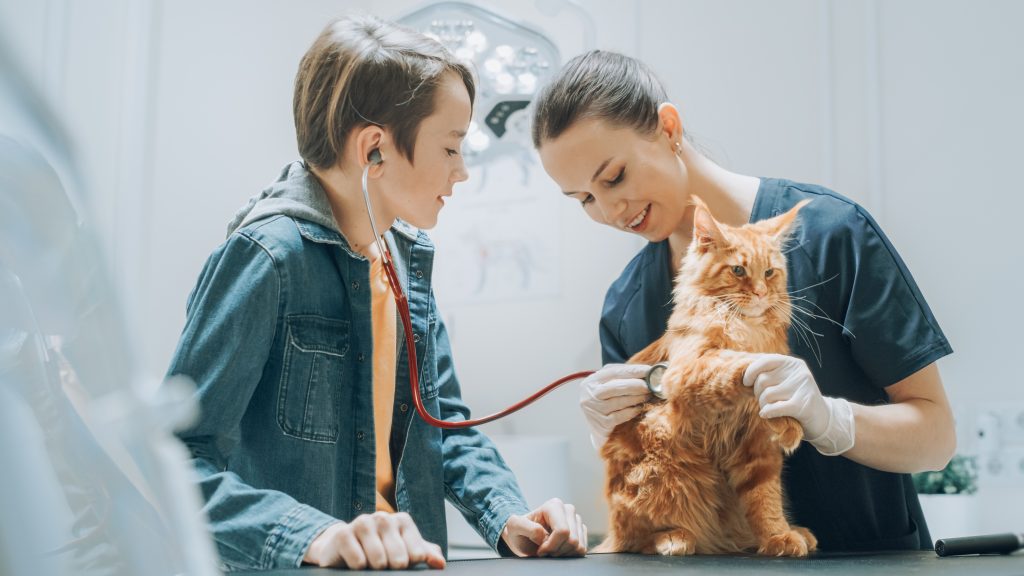Soft Skills: An Essential Pillar of Animal Health Training
Empathy, active listening, clear communication, and the ability to manage emotions or conflict, these non-technical skills, or soft skills, are now central to the work of veterinarians, vet nurses, vet receptionists, and sales representatives. They directly influence client relationships, care quality, job satisfaction, and even the reputation of a clinic or company (Pun, 2020 ; McDermott, 2015).
Yet, many professionals still feel ill-prepared to handle difficult conversations, announcing an uncertain diagnosis, discussing treatment costs, or guiding end-of-life decisions (Hamood et al., 2014). This gap is not due to lack of interest, but to structural limitations in training methods.
The Limits of Traditional Methods for Developing Soft Skills
Training organizations increasingly recognize the importance of communication. In vet schools, the competency model is now designed to balance technical expertise (hard skills) and interpersonal or behavioral abilities (soft skills), in line with European standards — particularly those set by the EAEVE (European Association of Establishments for Veterinary Education). However, traditional learning tools often fall short when it comes to transforming knowledge into genuine behavioral change.
Role-Play: Useful, But Imperfect
In-person role-plays allow for practice, usually only once. They can be stressful (especially under peer observation), dependent on the instructor, and not reproducible: each session is unique, offering inconsistent experiences between learners.
Feedback quality varies and is rarely structured, though structured reflection is key to progress (Radford et al., 2003 ; Rønning et al., 2019).
Lectures: Theory Without Practice
Communication is learned through action, not just instruction. Lectures and workshops provide essential foundations but do not allow learners to embody behaviors — such as managing objections, reformulating concerns, or asking effective questions (Lavanya et al., 2024). As a result, intellectual understanding rarely becomes practical skill.
On-the-Job Learning: Valuable But Uneven
During internships or early professional experience, real-life encounters vary widely from one learner to another. Without structured guidance or targeted feedback, learning depends largely on luck — on the type of cases encountered and the supervisor’s approach (Baillie et al., 2010).

What Veterinary Education and Communication Research Reveal About Soft Skills Learning
Educational research and learning sciences converge on several findings:
- Soft skills require regular practice, constructive feedback, and a psychologically safe environment (Rønning et al., 2019).
- Many young veterinarians report feeling underprepared for client communication (McDermott, 2015 ; Danış & Yaşar, 2025).
- Interprofessional surveys reveal significant variability among schools in how relational skills are taught (Rauch et al., 2021).
A recent study in Animals introduced the concept of Hierarchically Structured Role-Playing Simulation, in which students play defined roles (leader, veterinarians, client) during simulated consultations. This structured model enhances collaboration, leadership, and client-centered communication, while fostering self-directed learning in a safe environment (Pérez-Écija et al., 2025).
The Limits of Traditional Methods for Developing Soft Skills
Conversation Simulations
Simulations — whether with actors, peers, or digital tools — offer repetition, scenario diversity, and structured feedback. They recreate real-world clinical challenges while maintaining a supportive and formative environment (Bahramsoltani et al., 2023 ; Baillie et al., 2010).
Scenario-Based Clinical Learning
Embedding soft skills within simulated clinical cases anchors learning in realistic context: diagnosing, delivering bad news, explaining treatment options. Debriefing then becomes a space for analysis and growth, rather than judgment (Janke et al., 2023).
Digital Tools and Artificial Intelligence
Virtual environments and AI-driven conversational tools open new horizons for learning:
- Personalized practice
- Instant feedback
- Unlimited repetition
- Reduced stress from peer observation
Recent studies demonstrate that virtual patients and AI chat-based simulations significantly improve communication skills in health education (Haut et al., 2023 ; Weisman et al., 2025).
These innovations are particularly promising for continuing veterinary education, offering flexible, accessible learning at any stage of one’s career.
Conclusion: Toward a New Era in Animal Health Education
Training soft skills can no longer be limited to occasional workshops. It is a continuous, iterative process, built on practice, confidence, and repetition.
Innovative methods – from structured simulations to AI-driven tools – offer unprecedented opportunities to strengthen communication, empathy, and trust in client relationships.
At Wolf Learning Consulting, we believe it’s time to rethink how communication is taught and practiced in the animal health sector.
💡 Coming soon: discover our latest innovation: an AI-powered conversational simulation designed to help animal health professionals train differently, with confidence.
References:
- Baillie, S., Crossan, A., Brewster, S. A., Mellor, D. J., & Reid, S. W. J. (2010). Fostering integrated learning and clinical professionalism through contextualized simulation. Journal of Veterinary Medical Education, 37(3), 282-289. https://doi.org/10.3138/jvme.37.3.282
- Bahramsoltani, M., Bröer, S., Langforth, S., Eule, C., Prior, A., Vogt, L., Li, T.-T., Schirone, R., Pohl, A., & Jensen, K. C. (2023). Outcome of communication training in veterinary studies: Influence on perception of competencies and self-assessment of communication skills. Animals, 13(9), 1516. https://doi.org/10.3390/ani13091516
- Danış, E. M., & Yaşar, A. (2025). Communication skills of veterinary practitioners in Türkiye. Canadian Veterinary Journal, 66(6), 645-652. https://pubmed.ncbi.nlm.nih.gov/40510274/
- Hamood, W. J., Chur-Hansen, A., & McArthur, M. L. (2014). A qualitative study to explore communication skills in veterinary medical education. International Journal of Medical Education, 5, 193-198. https://doi.org/10.5116/ijme.542a.975d
- Haut, K. G., Wohn, C., Kane, B., & al. (2023). Validating a virtual human and automated feedback system for training doctor-patient communication skills (SOPHIE). arXiv Preprint, arXiv:2306.15213. https://doi.org/10.48550/arXiv.2306.15213
- Janke, N., et al. (2023). On-site communication skills education increases client communication outcomes in a veterinary practice setting. Journal of the American Veterinary Medical Association. https://avmajournals.avma.org
- Lavanya, K. M., et al. (2024). Effectiveness of scenario-based roleplay as a method for teaching communication and teamwork. Journal of Education and Health Promotion, 13, 11189269. https://www.ncbi.nlm.nih.gov/pmc/articles/PMC11189269/
- McDermott, M. P. (2015). Veterinarian–Client Communication Skills: Current State and Implications. Journal of Veterinary Medical Education, 42(3), 235-243. https://doi.org/10.3138/jvme.0115-006R
- Pérez-Écija, A., Buzón-Cuevas, A., De las Heras, A., & Mendoza, F. J. (2025). Hierarchically structured role-playing simulation as a tool for promoting soft skills in veterinary undergraduates. Animals, 15(11), 1638. https://doi.org/10.3390/ani15111638
- Pun, J. K. H. (2020). An integrated review of the role of communication in veterinary clinical practice. BMC Veterinary Research, 16, 394. https://doi.org/10.1186/s12917-020-02558-2
- Radford, A. D., Stockley, P., Silverman, J., Taylor, I., Turner, R., & Armitage-Chan, E. (2003). Use of simulated clients in training veterinary students. Veterinary Record, 152(11), 422-427. https://doi.org/10.1136/vr.152.13.422
- Rauch, M., Wissing, S., Tipold, A., & et al. (2021). Interprofessional survey on communication skills in veterinary and veterinary-related education in Germany. BMC Medical Education, 21, 516. https://doi.org/10.1186/s12909-021-02938-8
- Rønning, S. B., et al. (2019). The use of clinical role-play and reflection in learning therapeutic communication skills: An integrative review. BMC Nursing, 18, 33. https://doi.org/10.1186/s12912-019-0355-9
- Weisman, D., et al. (2025). Development of a GPT-4–powered virtual simulated patient for communication training. medRxiv Preprint. https://www.ncbi.nlm.nih.gov/pmc/articles/PMC12046251/
